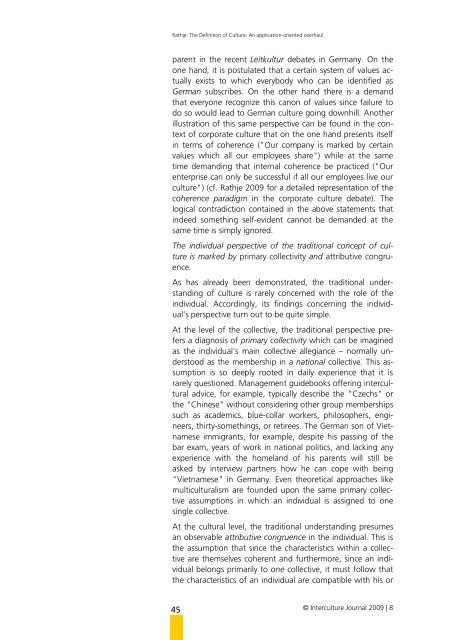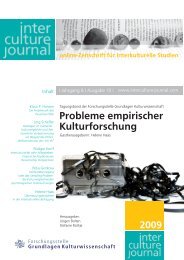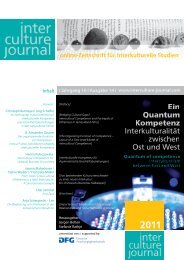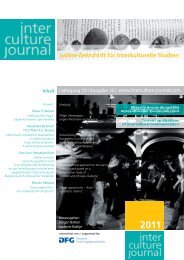Grundlagen Kulturwissenschaft - Interculture Journal
Grundlagen Kulturwissenschaft - Interculture Journal
Grundlagen Kulturwissenschaft - Interculture Journal
Sie wollen auch ein ePaper? Erhöhen Sie die Reichweite Ihrer Titel.
YUMPU macht aus Druck-PDFs automatisch weboptimierte ePaper, die Google liebt.
Rathje: The Definition of Culture: An application-oriented overhaul<br />
parent in the recent Leitkultur debates in Germany. On the<br />
one hand, it is postulated that a certain system of values actually<br />
exists to which everybody who can be identified as<br />
German subscribes. On the other hand there is a demand<br />
that everyone recognize this canon of values since failure to<br />
do so would lead to German culture going downhill. Another<br />
illustration of this same perspective can be found in the context<br />
of corporate culture that on the one hand presents itself<br />
in terms of coherence ("Our company is marked by certain<br />
values which all our employees share") while at the same<br />
time demanding that internal coherence be practiced ("Our<br />
enterprise can only be successful if all our employees live our<br />
culture") (cf. Rathje 2009 for a detailed representation of the<br />
coherence paradigm in the corporate culture debate). The<br />
logical contradiction contained in the above statements that<br />
indeed something self-evident cannot be demanded at the<br />
same time is simply ignored.<br />
The individual perspective of the traditional concept of culture<br />
is marked by primary collectivity and attributive congruence.<br />
As has already been demonstrated, the traditional understanding<br />
of culture is rarely concerned with the role of the<br />
individual. Accordingly, its findings concerning the individual’s<br />
perspective turn out to be quite simple.<br />
At the level of the collective, the traditional perspective prefers<br />
a diagnosis of primary collectivity which can be imagined<br />
as the individual's main collective allegiance – normally understood<br />
as the membership in a national collective. This assumption<br />
is so deeply rooted in daily experience that it is<br />
rarely questioned. Management guidebooks offering intercultural<br />
advice, for example, typically describe the "Czechs" or<br />
the "Chinese" without considering other group memberships<br />
such as academics, blue-collar workers, philosophers, engineers,<br />
thirty-somethings, or retirees. The German son of Vietnamese<br />
immigrants, for example, despite his passing of the<br />
bar exam, years of work in national politics, and lacking any<br />
experience with the homeland of his parents will still be<br />
asked by interview partners how he can cope with being<br />
"Vietnamese" in Germany. Even theoretical approaches like<br />
multiculturalism are founded upon the same primary collective<br />
assumptions in which an individual is assigned to one<br />
single collective.<br />
At the cultural level, the traditional understanding presumes<br />
an observable attributive congruence in the individual. This is<br />
the assumption that since the characteristics within a collective<br />
are themselves coherent and furthermore, since an individual<br />
belongs primarily to one collective, it must follow that<br />
the characteristics of an individual are compatible with his or<br />
45<br />
© <strong>Interculture</strong> <strong>Journal</strong> 2009 | 8









